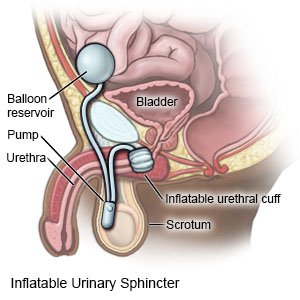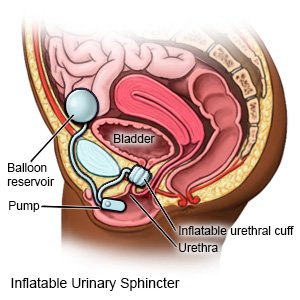Urinary Sphincter Replacement
Medically reviewed by Drugs.com. Last updated on Aug 4, 2025.
Urinary sphincter replacement is surgery to replace your urinary sphincter with an artificial urinary sphincter (AUS). The urinary sphincter is a muscle that surrounds your urethra. The sphincter squeezes the urethra to keep urine in the bladder until it is time to urinate. An AUS device has a balloon reservoir, a cuff, and a pump. When the AUS is turned on, liquid inside the balloon flows into the cuff. When the cuff is filled, it squeezes your urethra to prevent urine from leaking out of your bladder. To urinate, you press the pump. This relaxes the cuff and allows urine to flow out of your bladder.
 |
 |
WHILE YOU ARE HERE:
Before your surgery:
- Informed consent is a legal document that explains the tests, treatments, or procedures that you may need. Informed consent means you understand what will be done and can make decisions about what you want. You give your permission when you sign the consent form. You can have someone sign this form for you if you are not able to sign it. You have the right to understand your medical care in words you know. Before you sign the consent form, understand the risks and benefits of what will be done. Make sure all your questions are answered.
- An IV is a small tube placed in your vein that is used to give you medicine or liquids.
- Antibiotics may be given through your IV before surgery.
- A sample of your urine will be tested to check for a urinary tract infection.
- Anesthesia is medicine to make you comfortable during the surgery. Healthcare providers will work with you to decide which anesthesia is best for you.
- General anesthesia will keep you asleep and free from pain during surgery. Anesthesia may be given through your IV. You may instead breathe it in through a mask or a tube placed down your throat. The tube may cause you to have a sore throat when you wake up.
- Spinal anesthesia is a shot of medicine put into your spine. It is used to numb the area and dull the pain. You may still feel pressure or pushing during surgery.
During your surgery:
- An incision will be made to reach your urethra. For men, the incision will be made in the scrotum or perineum (area between the penis and anus). For some men, the entire surgery may be done through the incision in the scrotum. For women, the incision will be made in the abdomen or vagina.
- Your surgeon will measure your urethra to choose the correct AUS cuff size. He or she will place the AUS cuff around your urethra. A small incision may be made in your lower abdomen to place the balloon reservoir. Tubing connected to the balloon reservoir is tunneled through your abdomen to reach the AUS pump.
- For men, the AUS pump will be placed in the scrotum. Tubing from the cuff is often tunneled down into the scrotum. For women, the pump is placed in the labia (skin folds found on each side of the vagina). Tubing from the cuff and the balloon reservoir will be connected to the pump. Your surgeon will check the pump to see that it works properly. Then he or she will turn the pump off. Your incisions will be stitched closed and covered with bandages.
Related medications
After your surgery:
You will be taken to a room to rest until you are fully awake. Healthcare providers will monitor you closely for any problems. Do not get out of bed until your healthcare provider says it is okay. When your healthcare provider sees that you are okay, you will be able to go home or be taken to your hospital room.
- A Foley catheter is a tube healthcare providers put into your bladder to drain your urine into a bag. Keep the bag below your waist. This will help prevent infection and other problems caused by urine flowing back into your bladder. Do not pull on the catheter, because this may cause pain and bleeding, and the catheter could come out. Keep the catheter tubing free of kinks so your urine will flow into the bag. Healthcare providers will remove the catheter as soon as possible, to help prevent infection.
- Your AUS will not be turned on for 6 to 8 weeks after surgery, to let the area heal first. After your Foley catheter is removed, you will leak urine. Healthcare providers will give you a pad to help absorb urine leaks until the AUS is turned on.
- Medicines may be given to prevent or treat pain or a bacterial infection.
RISKS:
You may bleed more than expected or develop an infection. You may have trouble urinating after the surgery. Your urethra, bladder, or nearby tissues may be damaged. Women may have bruising or damage to the labia or vagina. Men may have bruising or damage to the scrotum. If your AUS becomes infected, it may need to be removed. Your urethra may be damaged by the pressure from the AUS cuff. The cuff may break down, or the tubing may become blocked. The AUS may not work and you may continue to leak urine. You may need another surgery to fix or replace the AUS.
CARE AGREEMENT:
You have the right to help plan your care. Learn about your health condition and how it may be treated. Discuss treatment options with your healthcare providers to decide what care you want to receive. You always have the right to refuse treatment.© Copyright Merative 2025 Information is for End User's use only and may not be sold, redistributed or otherwise used for commercial purposes.
The above information is an educational aid only. It is not intended as medical advice for individual conditions or treatments. Talk to your doctor, nurse or pharmacist before following any medical regimen to see if it is safe and effective for you.
Further information
Always consult your healthcare provider to ensure the information displayed on this page applies to your personal circumstances.
